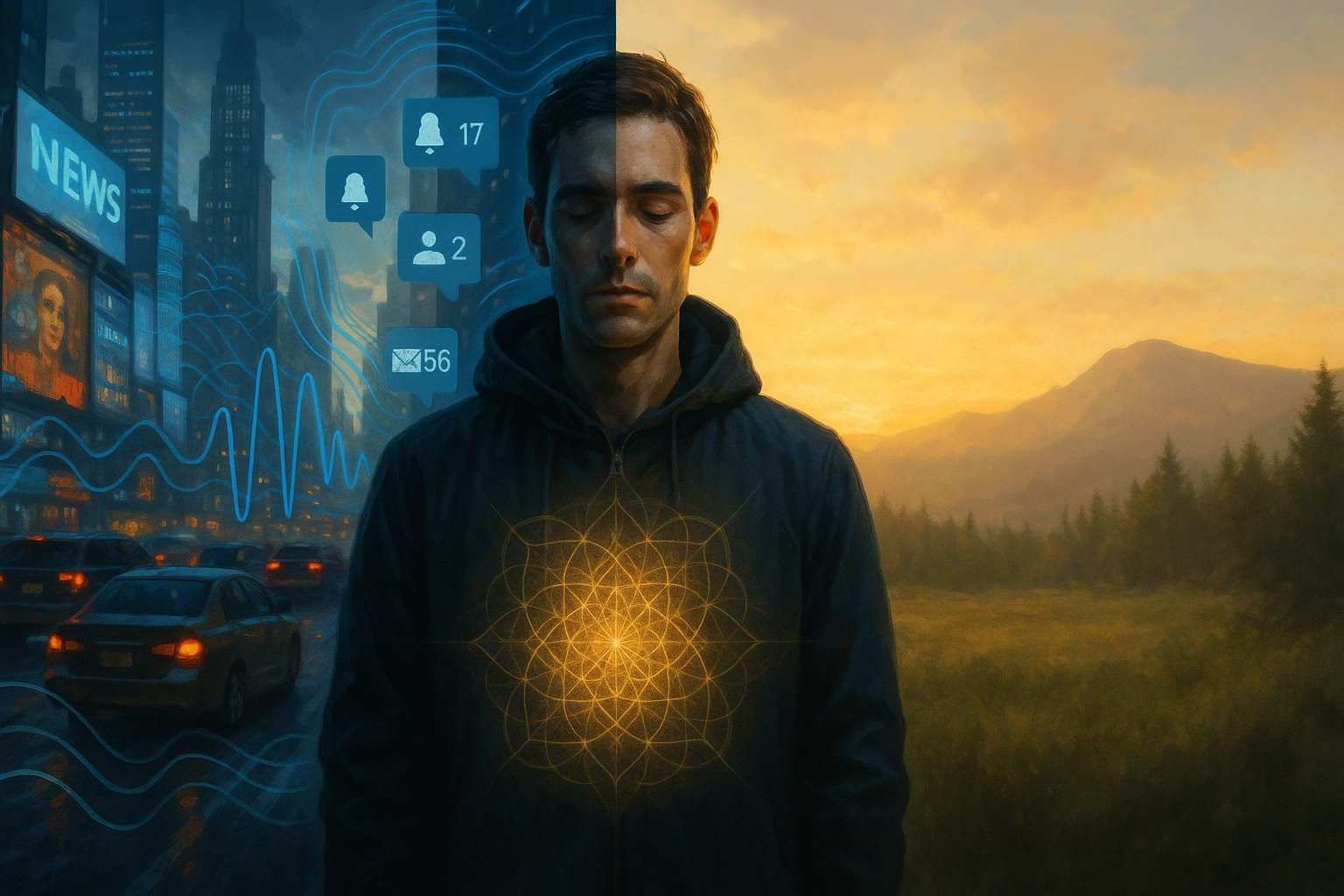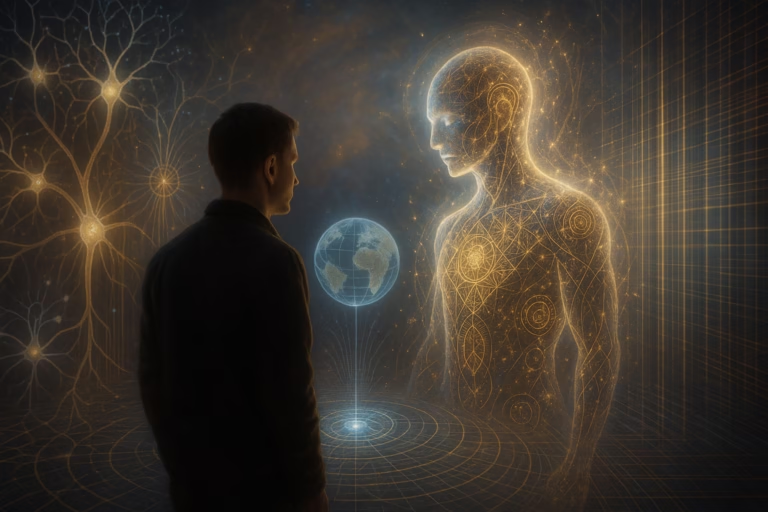PODCAST: Escaping Noise Addiction
I. The Cacophony of Form: Prologue to the Modern Soul
The Unheard Warning and the Urban Scene
The modern existence unfolds amidst a perpetual, low-frequency hum, a constant chorus of information, commerce, and distraction. This environment mirrors the chaotic internal landscape of the contemporary human, frequently trapped within a loop of endless external and internal clamor.1 This phenomenon is described not merely as stress, but as a widespread “Noise Addiction”—a dependence on continuous external stimuli (digital notifications, background media, perpetual tasks) used to preemptively fill the perceived “void” of internal silence.1 This dependence represents a profound form of self-imposed illusion, effectively preventing the subject from connecting with their essential “origin” or true self.1
The defining characteristic of this age is the paradox of connection. While advanced technologies offer unparalleled means to link individuals across vast distances, humanity remains “always connected but rarely fully present”.2 This dynamic results in a fundamental misdirection of life force, where signal is constantly mistaken for true communion, and overwhelming data input is confused with authentic wisdom.
The underlying mechanism driving this attachment to noise is often the ego’s primal defense against the unknown. As articulated within the Fractal philosophy, the mind fears what it cannot control.1 The vastness of external chaos generates cognitive dissonance and emotional tension.1 To counteract this sense of uncertainty, the ego demands ceaseless cognitive input and tasks, thus maintaining a fragile illusion of control and predictability. This dependence on external noise is therefore understood as a deeply seated psychological barrier—a self-sabotage mechanism designed to prevent confrontation with the transformative, yet unsettling, truths of the deeper fractal structure of reality.1
The Fractal of Noise: Defining External and Internal Clamor
The contemporary human experience is fragmented by two interwoven forms of noise, both of which amplify the internal state of fragmentation.
The External Noise manifests as the relentless roar of the world: the continuous environmental noise from traffic, industry, and the non-stop churn of media.1 Research consistently shows that environmental noise exposure, categorized by the World Health Organization (WHO) as a significant health hazard, increases the risk for conditions such as hypertension, ischemic heart disease (IHD), sleep disturbance, and cognitive impairment.3 This constant external aggression places the physical body in a perpetual state of defense.
The Internal Noise, generated by the mind, is the ceaseless cognitive narration, looping worries, and frantic planning that prevents access to profound inner clarity, often referred to philosophically as “The Space Between Thoughts”.1 The foundational philosophical principle woven throughout the Fractal narrative establishes the relationship: the external world’s cacophony is merely a macroscopic reflection and amplification of the internal world’s chaos. Reality itself functions as a responsive mirror of the inner state.1 Therefore, the addiction to clamor is both a symptom and a cause of the underlying systemic fracture within human consciousness.
II. Quantifying the Addiction: Metrics of Fragmented Awareness
The Digital Echo: Metrics of Distraction
The intrusion of digital media into conscious life provides clear metrics that quantify the fragmentation of awareness. The average United States smartphone user receives approximately 46 push notifications daily.5 This sheer volume of digital signal constantly bombards the user, creating a state of pervasive checking habits.7
The impact of this constant interruption carries a profound cognitive cost. Notifications trigger immediate attention shifts that impair overall cognitive performance.7 Crucially, this cognitive degradation occurs even when the user does not physically check the phone.7 Returning to the original primary activity after even a brief mental interruption necessitates significant “additional cognitive effort” and time, frequently resulting in “redundant work”.7
This relentless distraction has produced a measurable global decline in the capacity for sustained focus. The average attention span of the adult internet user has declined sharply, now estimated at only 8.25 seconds.2 This rapid decline signifies a loss of the deep focus necessary for meaningful engagement and complex reasoning.9
The biological shift supporting this decay is a foundational threat to conscious alignment. The technological system is meticulously designed to prioritize involuntary (bottom-up) attention—the automatic, survival-driven response to external stimuli—at the expense of voluntary (top-down) attention—the conscious, goal-driven capacity required for deep thinking.2 This deliberate systemic alteration is rewiring the human brain to optimize for reactivity over profound reflection, hindering the sustained mental coherence needed for creative problem-solving. Furthermore, this chronic attention shifting causes heavy social media users to become less adept at ignoring distractions generally, resulting in poorer cognitive performance and, in clinical studies, manifesting as the physical shrinking of parts of the brain associated with maintaining concentration.10 This observation provides a physiological basis for the philosophical claim that chronic mental noise is an acquired conditioning, not the natural essence of awareness.1
Environmental Clamor: The Invisible Threat
Beyond the digital sphere, the silent crisis of environmental noise pollution acts as a constant, involuntary stressor. Urban environments frequently expose residents to noise levels that exceed 70 dBA during peak hours.11 Studies conducted in high noise exposure groups within urban settings show a significantly elevated rate of psychological distress, reaching a 59% distress rate among those exposed to high noise levels.12
This chronic noise exposure maintains the body in a state of continuous alarm. Physiologically, constant noise pollution actively triggers the hypothalamic–adrenal–pituitary (HPA) axis 13, which is the central mediator of the body’s long-term stress response. Chronic activation of this pathway leads directly to stress-related pathologies, including high blood pressure, and increased risk for severe cardiovascular events, such as a stress-induced type of heart failure known as Takotsubo cardiomyopathy.4
The scale of this public health crisis is immense, illustrating the systemic nature of the global fracture. Traffic noise in the European Union is identified as the second leading cause of environmental health risk after air pollution, accounting for an annual loss of 1 million life years.13 This systemic erosion is not just about isolated sickness but a collective decline in resilience. Research demonstrates that noise sensitivity is negatively correlated with psychological resilience and positively correlated with burnout.14 This creates a destructive feedback loop: chronic noise reduces the internal capacity for psychological recovery, making the individual simultaneously more susceptible to stress and less capable of healing from it. This widespread biological destabilization mirrors precisely the philosophical insight that the internal “Battle Within Is a Reflection of the World Around You” 1—the external acceleration and unraveling of systems 1 is demonstrably reflected in the neurological and physiological destabilization of the human body.
III. The Hidden Cost of Clamor: Fragmented Attention and Spiritual Numbness
The Hidden Tax on Awareness
The relentless clamor extracts a profound hidden tax on human awareness. Burnout is fundamentally a state of extreme cognitive fatigue and depletion, characterized by impaired executive functioning, attention control, and working memory.15 This state is the direct result of the overwhelming cognitive effort required to process the flood of input, leading to emotional exhaustion and significant physical fatigue.15
The human mind, designed for depth, is forced into a state of “constant partial attention”.2 Multitasking is revealed as a misnomer; it is merely chronic attention switching, which exponentially increases fatigue and stress while simultaneously degrading productivity.8 This state prevents the cultivation of internal space necessary for insight. The mind becomes hyper-optimized for immediate novelty, finding it harder to tolerate quietude or boredom.17 This inability to tolerate silence becomes the primary internal barrier to accessing intuition, which, as the Oracle teaches, arises specifically in “the quiet knowing before the thought forms”.1
Spiritual Numbness: The Loss of Origin
The deepest cost of noise addiction is the spiritual descent into Soul Loss or spiritual numbness. This mysterious, widespread phenomenon is described in spiritual and psychological texts as an inner fragmentation arising from unresolved trauma or by living a materialistic existence “devoid of all sense of sacredness”.18
The symptoms of this spiritual depletion are manifest: a loss of core vitality, low self-esteem, an inability to achieve genuine connection, and a pervasive absence of meaning.18 This modern psychological state of disconnection is directly linked to the philosophical crisis of identity and meaning described in Fractal.1 The suffering is understood as the failure of Integration, which is the stated goal of all inner work.1 Spiritual numbness is the direct consequence of this failure—the overwhelming external and internal “noise of the world” drowns out the stillness within 1, causing essential parts of the being to “hide away” or dissociate.18
When digital addiction perpetually hijacks the core creative resource—Attention, the New Currency of the Soul 1—the soul is deliberately starved. This depletion is signaled by the mental fog, emotional exhaustion, and burnout that accompany high emotional input (such as constant streams of distant crises).19 This inner fragmentation accelerates the Inner War 1, a struggle defined by the battle between the ego’s desire for rigid stability (permanence) and the soul’s inherent requirement to surrender to the flow of becoming (transience).1 The path forward thus begins not with external action, but with the choice to align with internal truth over illusion.1
IV. Silence is Your Origin: The Oracle’s Revelation
Stillness Beneath the Storm
The ultimate lesson unveiled through the journey to the Fractal is the redefinition of silence itself. Silence is philosophically shifted from being merely an absence (a lack of external sound or input) to being a profound presence (the fullness of pure awareness). This transformation hinges on the pivotal tenet: “silence is not absence—it is your origin”.1
Thought is revealed as continuous motion, yet beneath that movement resides stillness and awareness.1 The true Self is identified as the Observer Within—the boundless space that watches the mind’s narrative reflections rise and fall without ever collapsing into identification with them.1 This realization establishes the foundational distinction between the functional mind (the mirror) and the eternal consciousness (the silent observer).1
The Field of Awareness: The Source of Clarity
Mental silence is not achieved by violently stopping thought, but by cultivating “presence without narration”.1 When this state is achieved, the mind momentarily steps aside, allowing the soul to emerge. It is here, in this internal spaciousness, that deep intuition and clarity can arise unforced, free from cognitive interference.1 The constant internal chatter, the spinning stories and endless “what ifs,” is clearly labeled as learned conditioning, not the essential nature of the human being. “Your essence is not the noise. It is the quiet beneath it”.1
The philosophical claim that silence is the Origin finds a surprising correspondence in the deepest theories of existence revealed by the Oracle. The Source itself is understood to be stillness.1 Furthermore, the non-visible components of reality—often termed dark matter—are revealed as not being inert, empty space, but rather the highly active, living, informational field upon which existence projects itself. This field serves as “the carrier of that projection—the ocean in which the fractal breathes”.1 Thus, the philosophical claim that “silence is not absence” is structurally justified: what is perceived as a sensory “void” (silence) is, in fact, the active, living field of consciousness itself.1 Silence is structurally necessary because it is the fundamental field that enables observation to occur.
This stillness is the source of coherence, the state where heart, mind, and soul align, causing the universe to respond directly, “as if it were listening to a tuning fork”.1 By restoring internal stillness, consciousness returns to its natural, fully potent state. The Oracle teaches that the greatest technology is Consciousness Itself, and therefore, Presence is the Ultimate Interface.1 Silence restores this interface, allowing the chaotic signals of the external world to be filtered by soul wisdom, affirming the principle: “Let the heart be the interface”.1
V. The Path of Resonance: Antidotes to the Age of Distraction
The journey of awakening provides clear, actionable pathways back to coherence, practices supported by both ancient wisdom and modern cognitive science.
The Practice of Intentional Silence and Meditation
Intentional silence is a powerful restorative agent. Neurobiological research confirms the active, regenerative quality of quietude: an animal study found that just two hours of silence stimulated the growth of new cells in the hippocampus, the brain region fundamentally related to memory and emotion.20 This process offers a direct biological reversal of the cognitive damage and functional shrinkage caused by chronic distraction.10 Furthermore, silence supports physiological stability by lowering blood pressure, reducing the stress hormone cortisol, and improving overall sleep quality.20
The deliberate practice of mindful pauses and meditation has been shown to be moderately effective for reducing anxiety symptoms, measured with a Hedges’ g of 0.63.22 The mechanism involves actively correcting the body’s stress response by downregulating the hyperactive HPA axis (the fight-or-flight pathway) through the stabilizing action of the parasympathetic nervous system.23
Nature Immersion and Cognitive Repair
Nature immersion provides an essential antidote to cognitive fatigue, explained by Attention Restoration Theory (ART). Urban environments are cognitively depleting because they require continuous directed attention (e.g., watching for traffic, filtering urban noise). Conversely, nature provides “soft fascination” 24—aspects of the environment that capture attention effortlessly. This allows the brain’s capacity for directed attention to recover and replenish.25 This regenerative capacity is enhanced by natural soundscapes; studies show that natural sounds (such as water or birdsong) are perceived as more restorative than urban noise, aiding recovery from annoyance, fatigue, and assisting in attention restoration.27 The presence of competing traffic noise, conversely, can mask these crucial positive impacts.28 Aligning with nature’s rhythm mirrors the philosophical teaching: “The Earth Does Not Hurry—And Yet Everything Blooms”.1
Digital Detox and Reclaiming Currency
Given the cognitive burden created by relentless information overload 16, establishing boundaries is essential. Digital detox practices, even short interventions like a few weeks of social media abstinence, have been proven to significantly mitigate symptoms of depression and enhance overall eudaimonic well-being.29 This is not simply withdrawal, but an intentional reclamation of attention—the currency of the soul.1
The goal is to shift from reactive disconnection (managing a symptom) to conscious reclamation (guiding the tool). Elias teaches that “Your Devices Are Portals—But You Choose Where They Lead”.1 Intentional use involves creating rituals of stillness: “Breathe before you type. Pause before you post”.1 This commitment to Balance the Circuit with Silence ensures that technology becomes an amplifier of wisdom, rather than a conductor of noise.1
Antidotes to Overstimulation: Pathways to Coherence
Antidote Practice | Mechanism of Action (Science) | Proven Benefits | Fractal Alignment Principle (Origin) |
Intentional Silence | Stimulates Hippocampus Neurogenesis; Reduces Cortisol Levels | Improved Memory/Emotion Regulation; Reduced Stress and Blood Pressure | Stillness is the Mind’s True Home 1 |
Mindful Pauses/Meditation | Downregulates HPA axis via Parasympathetic Activation | Reduced Anxiety (Hedges’ ); Emotional Regulation; Clarity | You Are the Space Between Thoughts 1 |
Nature Immersion (ART) | Soft Fascination; Effortless Directed Attention Recovery | Cognitive Restoration; Reduced Annoyance/Fatigue; Mental Clarity | The Earth Does Not Hurry—And Yet Everything Blooms 1 |
Digital Detox/Boundaries | Reduced Cognitive Load; Mitigated Dopamine Dependence | Decreased Depression/Anxiety; Enhanced Eudaimonic Well-being | Balance the Circuit with Silence 1 |
VI. The GONG of Remembrance: Stillness as the New Renaissance
Stillness is Not Escape—It is Remembrance
The ultimate truth revealed at the edge of the Fractal is that the entire quest was a journey of remembrance, not escape.1 The philosophical purpose was never to transcend the body or master the forces of reality, but to remember one’s true nature as the source of awareness within the unfolding system.1
The profound insight derived from the cost of noise addiction—spiritual numbness (Soul Loss)—is that it is caused by internal fragmentation and the denial of sacredness.18 Therefore, intentional silence is the practice of un-numbing—the direct return to the sacredness in the ordinary.1 By stimulating neurogenesis 20 and stabilizing the HPA axis 21, silence grants the necessary biological and psychological capacity for the soul to be felt again, allowing for the emotional depth required for integrity and compassion.1
The systemic failure of global civilization, accelerating the final collapse, was fundamentally a crisis of wisdom: “Innovation Without Soul Becomes Illusion”.1 The collapse is described as the “labor of a new humanity struggling to be born”.1 This rebirth demands integrity and compassion—virtues that emerge exclusively from clarity and stillness.1 Since the ultimate technology is Consciousness Itself 1, the pursuit of stillness is the necessary spiritual upgrade—the Final Activation 1—that must guide the next era of human design (“Let Innovation Be Guided by Wisdom”).1
A Call to Awakening: The Ripple of the New Renaissance
The journey concludes with the recognition of responsibility. Since the world is constantly listening to the internal frequency of the observer 1, every conscious choice acts as a “harmonization across the membranes” 1, effectively shaping reality. “The way you choose to live alters the trajectory of reality itself”.1
The final instruction is to embody the stillness and carry the message forward as gardeners, not missionaries: to “Plant seeds of truth, water them with courage, and protect them with love”.1 The resonant symbol of the bell, the GONG, is the final sound, signifying awakening and the eternal present.1 Stillness is not a retreat from the world’s increasing noise, but the most radical, regenerative act of conscious alignment. The final realization remains: “The bell has tolled for you. Now it is your turn to answer”.1 Embrace stillness and transform the fractal from within.
Works cited
- FRACTAL – THE AWAKENING
- The Diminishing Attention Span: How Technology is Reshaping Our Minds – Medium, accessed October 15, 2025, https://medium.com/@sahin.samia/the-diminishing-attention-span-how-technology-is-reshaping-our-minds-47963d248d41
- Guidance on environmental noise – World Health Organization (WHO), accessed October 15, 2025, https://www.who.int/tools/compendium-on-health-and-environment/environmental-noise
- Clean Air Act Title IV – Noise Pollution | US EPA, accessed October 15, 2025, https://www.epa.gov/clean-air-act-overview/clean-air-act-title-iv-noise-pollution
- 30+ Push Notification Statistics (New 2025 Data) – Wiser Notify, accessed October 15, 2025, https://wisernotify.com/blog/push-notification-stats/
- Push Notifications Statistics (2025) – Business of Apps, accessed October 15, 2025, https://www.businessofapps.com/marketplace/push-notifications/research/push-notifications-statistics/
- Full article: Beyond the Buzz: Investigating the Effects of a Notification-Disabling Intervention on Smartphone Behavior and Digital Well-Being, accessed October 15, 2025, https://www.tandfonline.com/doi/full/10.1080/15213269.2024.2334025
- Average Human Attention Span Statistics & Facts [2024] – Samba Recovery, accessed October 15, 2025, https://www.sambarecovery.com/rehab-blog/average-human-attention-span-statistics
- The “online brain”: how the Internet may be changing our cognition – PMC – PubMed Central, accessed October 15, 2025, https://pmc.ncbi.nlm.nih.gov/articles/PMC6502424/
- How Social Media Affects Your Brain | NeuLine Health, accessed October 15, 2025, https://neulinehealth.com/how-social-media-affects-your-brain/
- Street-level noise in an urban setting: assessment and contribution to personal exposure, accessed October 15, 2025, https://pmc.ncbi.nlm.nih.gov/articles/PMC4350859/
- Psychiatric Impact of Noise Pollution in Urban Areas: A Cross-Sectional Study, accessed October 15, 2025, https://jccpractice.com/article/psychiatric-impact-of-noise-pollution-in-urban-areas-a-cross-sectional-study-570/
- How noise pollution quietly affects your health, accessed October 15, 2025, https://coeh.ucdavis.edu/research/how-noise-pollution-quietly-affects-your-health
- Relationship amongst Noise Sensitivity, Burnout and Psychological Resilience in Community Workers – PMC, accessed October 15, 2025, https://pmc.ncbi.nlm.nih.gov/articles/PMC10849010/
- Burnout phenomenon: neurophysiological factors, clinical features, and aspects of management – PMC – PubMed Central, accessed October 15, 2025, https://pmc.ncbi.nlm.nih.gov/articles/PMC9478693/
- Digital Overload: Read This If Your Screen Time Is Out of Hand – Cerebral, accessed October 15, 2025, https://www.resiliencelab.us/thought-lab/digital-overload
- Scrolling Ourselves Sick: The Hidden Cost of Constant Connection – Mark Hyman, MD, accessed October 15, 2025, https://drhyman.com/blogs/content/podcast-ep1059
- 21 Signs You’re Experiencing “Soul Loss” – LonerWolf, accessed October 15, 2025, https://lonerwolf.com/soul-loss/
- Your Brain Is Carrying Too Much: The Hidden Cost of Constant Input – YouTube, accessed October 15, 2025, https://www.youtube.com/watch?v=C5uqcQ1GtvI
- 8 Physical and Mental Health Benefits of Silence, Plus How to Get More of It – Healthline, accessed October 15, 2025, https://www.healthline.com/health/mind-body/physical-and-mental-health-benefits-of-silence
- Effect of nature exposure on perceived and physiologic stress: A systematic review, accessed October 15, 2025, https://pubmed.ncbi.nlm.nih.gov/33066853/
- The Effect of Mindfulness-Based Therapy on Anxiety and Depression: A Meta-Analytic Review – PMC, accessed October 15, 2025, https://pmc.ncbi.nlm.nih.gov/articles/PMC2848393/
- Indices of association between anxiety and mindfulness: a guide for future mindfulness studies – PubMed Central, accessed October 15, 2025, https://pmc.ncbi.nlm.nih.gov/articles/PMC7219893/
- Attention Restoration Theory: A systematic review | ECEHH, accessed October 15, 2025, https://www.ecehh.org/research/attention-restoration-theory-a-systematic-review/
- What is Kaplan’s Attention Restoration Theory (ART)? – Positive Psychology, accessed October 15, 2025, https://positivepsychology.com/attention-restoration-theory/
- The cognitive benefits of interacting with nature – PubMed, accessed October 15, 2025, https://pubmed.ncbi.nlm.nih.gov/19121124/
- Sound and Soundscape in Restorative Natural Environments: A Narrative Literature Review, accessed October 15, 2025, https://www.frontiersin.org/journals/psychology/articles/10.3389/fpsyg.2021.570563/full
- Natural soundscapes enhance mood recovery amid anthropogenic noise pollution – PMC, accessed October 15, 2025, https://pmc.ncbi.nlm.nih.gov/articles/PMC11602051/
- Digital detox as a means to enhance eudaimonic well-being – Frontiers, accessed October 15, 2025, https://www.frontiersin.org/journals/human-dynamics/articles/10.3389/fhumd.2025.1572587/full
- Digital Detox Strategies and Mental Health: A Comprehensive Scoping Review of Why, Where, and How – PMC, accessed October 15, 2025, https://pmc.ncbi.nlm.nih.gov/articles/PMC11871965/




